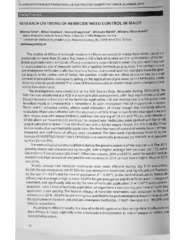Приказ основних података о документу
The importance of herbicde application time for succesfull weed control in maize
| dc.creator | Simić, Milena | |
| dc.creator | Brankov, Milan | |
| dc.creator | Dragičević, Vesna | |
| dc.creator | Babic, Milosav | |
| dc.creator | Milenković, Milena | |
| dc.date.accessioned | 2022-10-26T07:21:07Z | |
| dc.date.available | 2022-10-26T07:21:07Z | |
| dc.date.issued | 2019 | |
| dc.identifier.isbn | 978-86-83017-35-5 | |
| dc.identifier.uri | http://rik.mrizp.rs/handle/123456789/1031 | |
| dc.description.abstract | The studies of different herbicide treatment effects on weeds in maize have been carried out worldwide for more than 30 years. But, there is still a lack of studies on the optimization of the herbicide application time. Herbicide efficacy is especially unpredictable when the chemical treatment is incorporated as one of measures within the cropping technology practices. The performance of pre - emergence herbicides is affected by many factors, but rainfall and soil moisture have the greatest impact. In the central part of Serbia, the weather conditions are often characterised by a small amount of precipitation during early spring, so the application of pre - emergence herbicides usually does not provide good control. This is one of the reasons why in recent times post - emergence treatments have dominated. The investigations were conducted at the MRI Zemun Polje, Belgrade during 2014-2016. The field trial was established as a RCB in a split - split plot arrangement, with four replications and with the aim to examine how time of the herbicide application - A) pre - emergence mix for grasses and broadleaf weeds of s - metolachlor + mesotrione, B) post - emergence mix of mesotrione + nicosu Ifuron and C) untreated control, affects weed infestation of maize trough the herbicide efficacy evaluation. Maize was cultivated with the application of N fertiliser in two forms (standard urea and slow release urea with urease inhibitor), and two row spacing of 50 cm and 70 cm, with density of 59.500 plants per ha and 83.333 plants per ha, respectively. Herbicides were applied with hand - held sprayer calibrated to deliver 15 I at 300 kPa ( 3 bar ) with a flat - fan nozzle (Teejet , 1.4 mm E 04-80). Three and six weeks after each herbicide application, the fresh biomass of uprooted weeds from 1 m² was measured, and coefficients of efficacy were calculated. The data were transformed from % by the formula ASIN(SQRT(V7/100))*(180/3,4159265) and statistically processed by ANOVA, and analysed by the LSD - test ( 5 % ).The meteorological conditions differed during the growing seasons of the experiment. The 2015 growing season was characterised by drought, with a higher average temperature (21.1'C) and a low amount of precipitation (285.4 mm.) Other two seasons, 2014 and 2016, were favourable and an exceptionally high amount of precipitation was recorded in 2014 (almost twice higher than in 2015 and 2016). Results showed that herbicide treatments were more efficient during the first evaluation 96.56% for pre - emergence and 97.52% for post emergence treatment, and significantly influenced by the year (P - 0.02*) and the time of application (P - 0.00**) in the second evaluation, herbicide efficacy was in average a slightly lower, 92.07% for pre emergence and 91.44% for post - emergence treatment, and significantly affected by the time of herbicide application (P - 0.00**) and some interactions - year x time of herbicide application , nitrogen form x row spacing and time of herbicide application x row spacing. The highest efficacy of herbicide treatments was obtained in the first evaluation in 2016 - 99.54% for pre - emergence and 99.60% for post - emergence treatment and with the application of standard urea and pre - emergence herbicides , in both row spacing - 99.39% and 99.02 %, respectively According to obtained results, the time of herbicide application has no significant influence on their efficacy in maiz , especially when a herbicide is incorporated as one of measures within the crop growing system. | sr |
| dc.language.iso | en | sr |
| dc.publisher | Belgrade : Plant protection society of Serbia | sr |
| dc.rights | openAccess | sr |
| dc.rights.uri | https://creativecommons.org/licenses/by/4.0/ | |
| dc.source | 8. Congress on plant protection "Integrated plant protection for sustainable crop production and forestry", Zlatibor, 25-29.11.2019. - Book of abstracts | sr |
| dc.subject | pre - emergence herbicides | sr |
| dc.subject | post - emergence herbicides | sr |
| dc.subject | efficacy of herbicide treatments | sr |
| dc.title | The importance of herbicde application time for succesfull weed control in maize | sr |
| dc.type | conferenceObject | sr |
| dc.rights.license | BY | sr |
| dc.citation.spage | 74 | |
| dc.citation.epage | 74 | |
| dc.identifier.fulltext | http://rik.mrizp.rs/bitstream/id/4912/bitstream_4912.pdf | |
| dc.identifier.rcub | https://hdl.handle.net/21.15107/rcub_rik_1031 | |
| dc.type.version | publishedVersion | sr |


